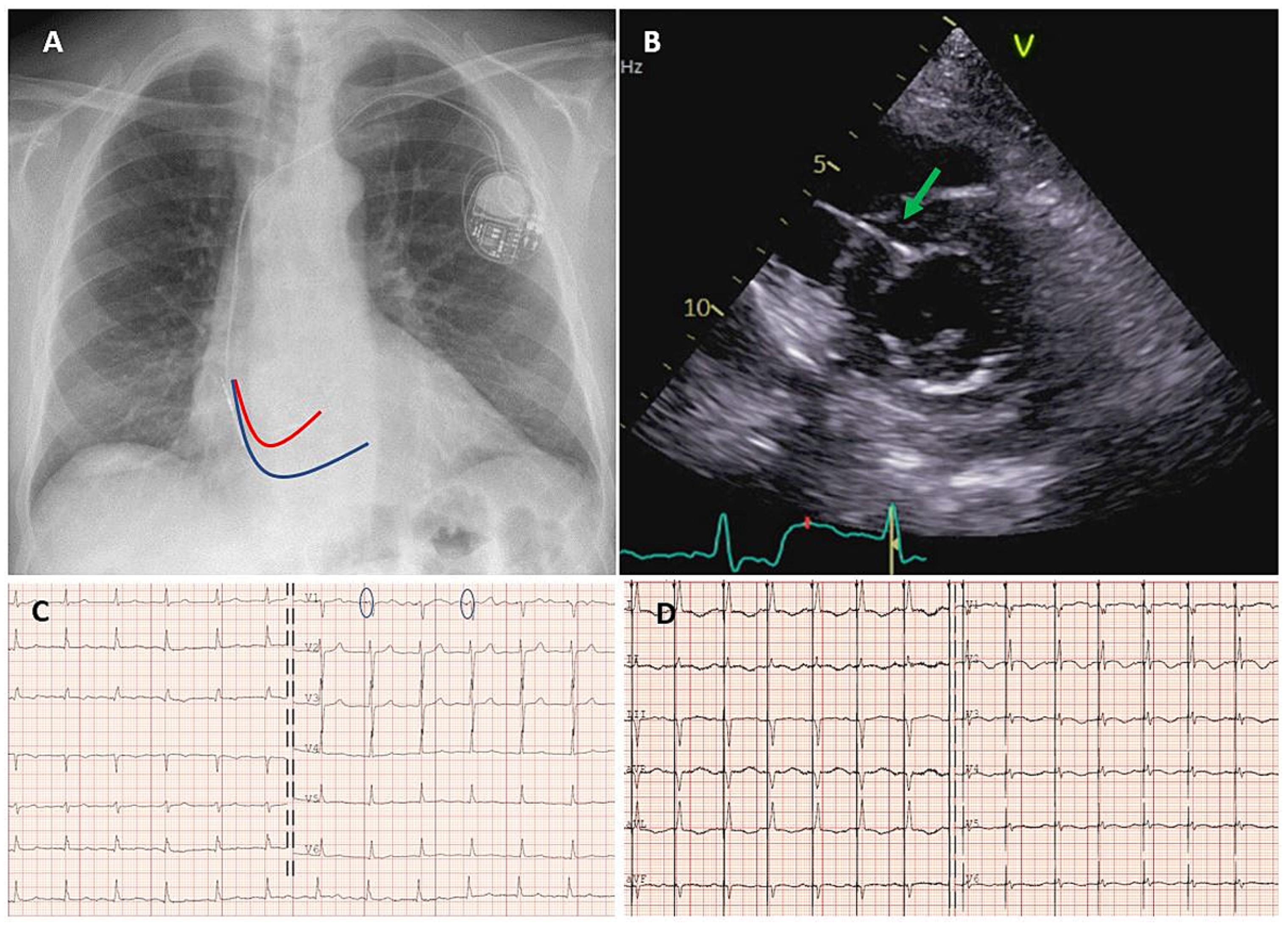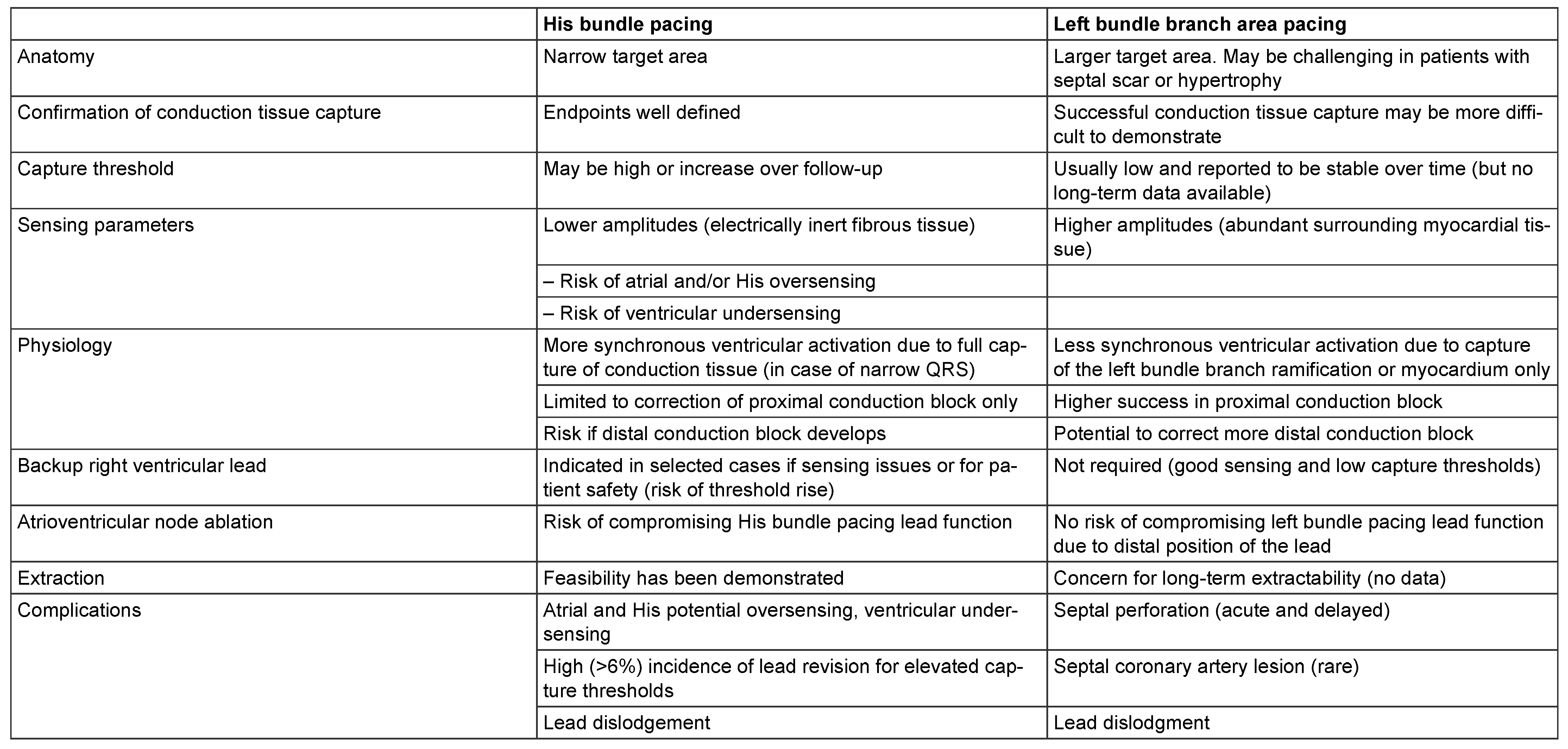His-Purkinje Conduction System Pacing
Abstract
Introduction
His bundle pacing
Implantation technique and success rates
His bundle pacing as an alternative to right ventricular pacing
His bundle pacing as an alternative to biventricular pacing
Left bundle branch (area) pacing
Implantation technique and success rates
Left bundle branch (area) pacing as an alternative to right ventricular pacing
Left bundle branch (area) pacing as an alternative to biventricular pacing
Key points
- −
- HBP and LBBAP are increasingly being adopted as alternatives to current standard right ventricular and biventricular pacing techniques.
- −
- HBP provides the most physiological ventricular activation, but there is concern about high capture thresholds and a high rate of lead revisions, which may be mitigated by a more liberal use of ventricular backup leads.
- −
- LBBAP is a recently introduced pacing modality, which seems to provide excellent electrical parameters (without the requirement for backup ventricular pacing), but the long-term performance and lead extractability remains to be evaluated. It is currently a valuable alternative if HBP does not yield satisfactory results.
- −
- Although there is a growing volume of observational data on these pacing modalities, there is a dire need for randomised studies to prove their safety and efficacy for them to be fully implemented in practice guidelines.
- −
- Patients expected to be paced >20% of the time (nodal and infra-nodal atrioventricular block; slowly conducted atrial fibrillation, pacing-induced cardiomyopathy)
- −
- As part of an ablate and pace strategy in rapidly conducted atrial fibrillation
- −
- Failed coronary sinus lead implantation for patients with a CRT indication
- −
- Non-responders to biventricular pacing
- −
- In combination with left ventricular or biventricular pacing for His-optimised CRT (in patients with permanent atrial fibrillation in whom the HBP or LBBAP lead may be connected to the atrial port)
Funding
References
- Ng, A.C.; Allman, C.; Vidaic, J.; Tie, H.; Hopkins, A.P.; Leung, D.Y. Long-term impact of right ventricular septal versus apical pacing on left ventricular synchrony and function in patients with second- or third-degree heart block. Am J Cardiol. 2009, 103, 1096–1101. [Google Scholar] [CrossRef]
- Deshmukh, P.; Casavant, D.A.; Romanyshyn, M.; Anderson, K. Permanent, direct His-bundle pacing: a novel approach to cardiac pacing in patients with normal His-Purkinje activation. Circulation 2000, 101, 869–877. [Google Scholar] [CrossRef]
- Beer, D.; Dandamudi, G.; Mandrola, J.M.; Friedman, P.A.; Vijayaraman, P. His-bundle pacing: impact of social media. Europace. 2019, 21, 1445–1450. [Google Scholar] [CrossRef]
- Kneller, J. His bundle pacing: new approach using stylet-supported pacing leads. EP Lab Dig. 2018, 18, 10–12.1535. [Google Scholar]
- Keene, D.; Arnold, A.D.; Jastrzębski, M.; Burri, H.; Zweibel, S.; Crespo, E.; et al. His bundle pacing, learning curve, procedure characteristics, safety, and feasibility: insights from a large international observational study. J Cardiovasc Electrophysiol. 2019, 30, 1984–1993. [Google Scholar] [CrossRef] [PubMed]
- Vijayaraman, P.; Dandamudi, G.; Lustgarten, D.; Ellenbogen, K.A. Permanent His bundle pacing: electrophysiological and echocardiographic observations from long-term follow-up. Pacing Clin Electrophysiol. 2017, 40, 883–891. [Google Scholar] [CrossRef] [PubMed]
- Teigeler, T.; Kolominsky, J.; Vo, C.; Shepard, R.; kalashasty, G.; Kron, J.; et al. Intermediate Term Performance and Safety of His Bundle Pacing Leads: A Single Center Experience. Heart Rhythm. 2021, 18, 743–749. [Google Scholar] [CrossRef]
- Burri, H.; Keene, D.; Whinnett, Z.; Zanon, F.; Vijayaraman, P. Device Programming for His Bundle Pacing. Circ Arrhythm Electrophysiol. 2019, 12, e006816. [Google Scholar] [CrossRef]
- Sharma, P.; Dandamudi, G.; Naperkowski, A.; Oren, J.; Storm, R.; Ellenbogen, K.; et al. Permanent HBP is feasible, safe and superior to RVP in routine clinical practice. Heart Rhythm. 2015, 12, 305–312. [Google Scholar] [CrossRef]
- Slotwiner, D.J.; Raitt, M.H.; Del-Carpio Munoz, F.; Mulpuru, S.K.; Nasser, N.; Peterson, P.N. Impact of physiologic pacing versus right ventricular pacing among patients with left ventricular ejection fraction greater than 35%: A systematic review for the 2018 ACC/AHA/HRS guideline on the evaluation and management of patients with bradycardia and cardiac conduction delay: A Report of the American College of Cardiology/ American Heart Association Task Force on Clinical Practice Guidelines and the Heart Rhythm Society. Heart Rhythm. 2019, 16, e280–e298. [Google Scholar] [CrossRef]
- Abdelrahman, M.; Subzposh, F.A.; Beer, D.; Durr, B.; Naperkowski, A.; Sun, H.; et al. Clinical outcomes of His bundle pacing compared to right ventricular pacing. J Am Coll Cardiol. 2018, 71, 2319–2330. [Google Scholar] [CrossRef]
- El-Sherif, N.; Amay-Y-Leon, F.; Schonfield, C.; Scherlag, B.J.; Rosen, K.; Lazzara, R.; et al. Normalization of bundle branch block patterns by distal His bundle pacing. Clinical and experimental evidence of longitudinal dissociation in the pathologic his bundle. Circulation. 1978, 57, 473–483. [Google Scholar] [CrossRef] [PubMed]
- Lustgarten, D.L.; Crespo, E.M.; Arkhipova-Jenkins, I.; Lobel, R.; Winget, J.; Koehler, J.; et al. His-bundle pacing versus biventricular pacing in cardiac resynchronization therapy patients: A crossover design comparison. Heart Rhythm. 2015, 12, 1548–1557. [Google Scholar] [CrossRef]
- Ajijola, O.A.; Upadhyay, G.A.; Macias, C.; Shivkumar, K.; Tung, R. Permanent His-bundle pacing for cardiac resynchronization therapy: initial feasibility study in lieu of left ventricular lead. Heart Rhythm. 2017, 14, 1353–1361. [Google Scholar] [CrossRef]
- Upadhyay, G.A.; Vijayaraman, P.; Nayak, H.M.; Verma, N.; Dandamudi, G.; Sharma, P.S.; et al.; His-SYNC Investigators On-treatment comparison between corrective His bundle pacing and biventricular pacing for cardiac resynchronization: A secondary analysis of the His-SYNC Pilot Trial. Heart Rhythm. 2019, 16, 1797–1807. [Google Scholar] [CrossRef]
- Huang, W.; Su, L.; Wu, S.; Xu, L.; Xiao, F.; Zhou, X.; et al. Long-term outcomes of His bundle pacing in patients with heart failure with left bundle branch block. Heart. 2019, 105, 137–143. [Google Scholar] [CrossRef] [PubMed]
- Sharma, P.S.; Dandamudi, G.; Herweg, B.; Wilson, D.; Singh, R.; Naperkowski, A.; et al. Permanent His-bundle pacing as an alternative to biventricular pacing for cardiac resynchronization therapy: A multicenter experience. Heart Rhythm. 2018, 15, 413–420. [Google Scholar] [CrossRef]
- Upadhyay, G.A.; Cherian, T.; Shatz, D.Y.; Beaser, A.D.; Aziz, Z.; Ozcan, C.; et al. Intracardiac delineation of septal conduction in left bundle branch block patterns: mechanistic evidence of left intrahisian block circumvented by His bundle pacing. Circulation. 2019, 140, e713–4. [Google Scholar] [CrossRef] [PubMed]
- Zweerink, A.; Zubarev, S.; Bakelants, E.; Potyagaylo, D.; Stettler, C.; Chmelevsky, M.; et al. His-optimized Cardiac Resynchronization Therapy (HOT-CRT) with Ventricular Fusion Pacing for Electrical Resynchronization in Heart Failure. JACC: Clin Electrophysiol. 2021, Online ahead of print. [CrossRef]
- Wu, S.; Sharma, P.; Huang, W. Novel left ventricular cardiac resynchronization. Europace. 2020, 22, ii10–ii8. [Google Scholar] [CrossRef]
- Huang, W.; Su, L.; Wu, S.; Xu, L.; Xiao, F.; Zhou Xet, a.l. A novel pacing strategy with low and stable output: pacing the left-bundle-branch immediately beyond the conduction block. Can J Cardiol 2017, 33, 1736.e1731–1736.e1733. [Google Scholar] [CrossRef]
- Li, Y.; Chen, K.; Dai, Y.; Li, C.; Sun, Q.; Chen, R.; et al. Left bundle branch pacing for symptomatic bradycardia: implant success rate, safety, and pacing characteristics. Heart Rhythm. 2019, 16, 1758–1765. [Google Scholar] [CrossRef]
- Li, X.; Li, H.; Ma, W.; Ning, X.; Liang, E.; Pang, K.; et al. Permanent left bundle branch area pacing for atrioventricular block: Feasibility, safety, and acute effect. Heart Rhythm. 2019, 16, 1766–1773. [Google Scholar] [CrossRef]
- Padala, S.; Ellenbogen, K. Left bundle branch pacing is the best approach to physiological pacing. Heart Rhythm O2 2020, 1, 59–67. [Google Scholar] [CrossRef] [PubMed]
- Su, L.; Wang, S.; Wu, S.; Xu, L.; Huang, Z.; Chen, X.; et al. Long term safety and feasibility of Left bundle branch pacing in a large single center study. Circ Arrhythm Electrophysiol. 2021, 14, e009261. [Google Scholar] [CrossRef]
- Huang, W.; Wu, S.; Vijayaraman, P.; Su, L.; Chen, X.; Cai, B.; et al. Cardiac resynchronization therapy in patients with non-ischemic cardiomyopathy utilizing left bundle branch pacing. JACC Clin Electrophysiol. 2020, 6, 859–862. [Google Scholar] [CrossRef] [PubMed]
- Vijayaraman, P.; Ponnusamy, S.; Cano, O.; Sharma, P.; Naperkowski, A.; Subsposh, F.; et al. Left Bundle Branch Area Pacing for Cardiac Resynchronization Therapy: Results From the International LBBAP Collaborative Study Group. J Am Coll Cardiol Clin Electrophysiol. 2020, 6, 849–858. [Google Scholar]
- Zweerink, A.; Bakelants, E.; Stettler, C.; Burri, H. Cryoablation vs. radiofrequency ablation of the atrioventricular node in patients with His bundle pacing. Europace. 2020, 1–10. [Google Scholar]

 |
© 2021 by the author. Attribution - Non-Commercial - NoDerivatives 4.0.
Share and Cite
Elise, B.; Haran, B. His-Purkinje Conduction System Pacing. Cardiovasc. Med. 2021, 24, 61. https://doi.org/10.4414/cvm.2021.02159
Elise B, Haran B. His-Purkinje Conduction System Pacing. Cardiovascular Medicine. 2021; 24(3):61. https://doi.org/10.4414/cvm.2021.02159
Chicago/Turabian StyleElise, Bakelants, and Burri Haran. 2021. "His-Purkinje Conduction System Pacing" Cardiovascular Medicine 24, no. 3: 61. https://doi.org/10.4414/cvm.2021.02159
APA StyleElise, B., & Haran, B. (2021). His-Purkinje Conduction System Pacing. Cardiovascular Medicine, 24(3), 61. https://doi.org/10.4414/cvm.2021.02159




